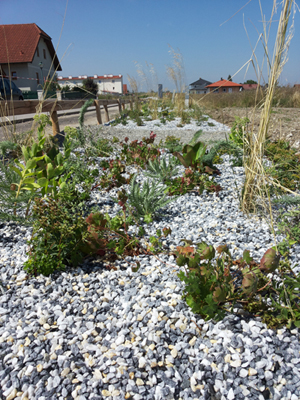Alpine Austrian municipalities are increasingly affected by climate change impacts, such as local extreme weather events (heavy precipitation, hailstorms), heat waves, droughts, declining snow cover, floods, and gravitational natural hazard events (debris flows, landslides, torrential processes, rockfall). A range of adverse effects on environmental systems, physical structures, human health, and socio-economic activities of all sectors (e.g., infrastructure, water supply, energy provision, forestry, tourism) is already causing frequent damages in municipalities, creating consequential costs to municipal households, and often jeopardizing municipal development potentials over the long term.
Like other local communities in the province of Lower Austria, the municipality of Ober-Grafendorf in the Mostviertel region has in recent years increasingly been affected by heavy precipitation events, on the one hand, and by more frequent and more pronounced drought periods, on the other hand. Due to the combined effect of heavy rainfall events and incremental soil sealing in the wake of ongoing settlement growth, excess surface water runoff from sealed surface areas has been causing overloading of sewage water systems and small-scale flooding of residential areas more and more frequently. The consequences are costly damages to properties and the built environment as well as rising costs for pumping out the sewerage and for operating the municipal wastewater treatment plant. The resulting maintenance and repair costs are causing substantial additional pressure on the municipal budget, which – as in most other municipalities - is strained by high investment and operation costs for the urban sewage and water sanitation infrastructure as well as for flood retention structures, anyway.
Moreover, in times of prolonged droughts the cost and effort for irrigating and maintaining the vegetation in urban green spaces has been increasing constantly, and the effects of more intense heat waves on human health and wellbeing are already being felt even in comparatively small rural municipalities.
Annual mean temperature has already risen by +2°C in Austria, compared to pre-industrial times. According to most recent regional climate change scenarios for the province of Lower Austria (Chimani et al. 2016a), which are based on the new Climate Scenarios for Austria (Chimani et al. 2016b), annual mean temperature is projected to increase further by +1.3°C to 1.4°C in the period 2021 to 2050 (compared to the period 1971-2000) and may rise up to +3.9°C under a business-as-usual representative concentration path (RCP8.5) in the period 2071 to 2100, with the strongest seasonal increase occurring in winter (+4.4°C). The average annual number of hot days (defined as days with the maximum daily temperature exceeding 30°C) in Lower Austria may increase from 6 hot days per year at present to 29 hot days per year until the end of the century. Though being subject to higher uncertainties, climate models also forecast an increase in annual mean precipitation of up to +11 % under a business-as-usual scenario until the end of the century and significant changes to seasonal precipitation amounts in the entire province, with an increase of +25.6% of precipitation amounts being possible during winter. Maximum daily precipitation amounts are simulated to increase significantly and in a progressive way in larger parts of Austria over the long term (RCP4.5: 16,2%; RCP8.5: 23,5%; both for the period 2071-2100), with the strongest changes of +20% to +40% occurring in winter in the north and east of Austria.
Having already been active in the fields of local energy efficiency, climate mitigation and environmental protection for years, the municipality of Ober-Grafendorf recognized the growing challenges to urban development induced by climate change and decided to test and implement an innovative local adaptation measure in a new municipal development area.



